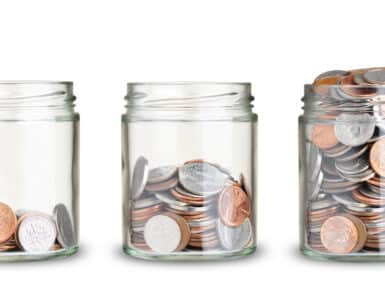Rising prices on rent, groceries, and gas have made it tougher for many Americans to stretch paychecks from one direct deposit to the next. And whether or not our economy dips into a textbook recession, we’ll likely continue to feel the impact of decades-high inflation for a while.
Savings is the Best Prevention Method
As families have more trouble making ends meet, their ability to save also has suffered. A 2022 survey from Bankrate reveals the following:
“Only 4 in 10 U.S. adults say they have enough money in savings to handle an unexpected expense of $1,000.”
With the Covid pandemic – and devastating winter storms – we are reminded that emergencies happen all the time. They are never convenient and often costly. That’s why having a cushion of cash tucked away in a savings account is one of the best ways to guard against using high-interest credit cards or loans to pay for unforeseen expenses.
If you’ve had trouble saving in the past, don’t sweat it. Now is a great time to resolve to save more in the months ahead. Here are some proven strategies to set yourself up for consistently spending less while stashing more of your hard-earned money aside for a more financially healthy future.
There’s an App for That
Those with access to the SavvyMoney tool can take advantage of an online budget planner to help track your spending night or day. Other apps and online tools are available from financial institutions to help keep tabs on account balances, pending deposits, and a host of other financial data. Once you begin depositing money into a separate savings account, tracking your progress by checking on your account balance every few weeks can feel as good – if not better – than the rush you get from buying new boots.
Build a Buffer
Sometimes, we have annual expenses that get us into a tight financial spot year after year. It can be auto insurance premiums, your property taxes, or school-related expenses.
To create a buffer, give yourself some grace and do the following:
- Open a separate account at your credit union or bank, aside from the one that holds your emergency fund.
- Divert some money every month to handle those unexpected expenses that often sneak up on us.
- Use your buffer funds to help cover unplanned expenses.
Do a Daily Check In
When you wake up in the morning, take one minute to think about what you are saving for. It helps to create a picture in your mind of the reason you want to save for the future. Maybe it’s so your child can attend the college of their choice. Picture them in a cap and gown receiving their diploma. Maybe it’s for a wedding or a much-anticipated vacation. Whatever your motivation is for setting money aside, make it more real by associating it with an image.
Another great way to remind yourself about why you are saving is to place a photo of your saving goal on your refrigerator door or your computer or mousepad – someplace you will see it every day – as a way to keep the idea fresh in your mind.
Pause Before You Purchase
When you find yourself standing in line in a store or sitting at home late at night with your laptop open to your favorite online store, do the following before you make the purchase:
- Pause for 30 seconds.
- Take a few moments to reflect on why you are buying the item.
- Ask yourself if you are doing this out of boredom or if this is an intentional purchase that is needed.
Often, taking a moment to reflect is enough to stop you from buying things you don’t truly need, and give you the willpower to close your computer or walk out of the store without the item.
With reporting by Casandra Andrews






